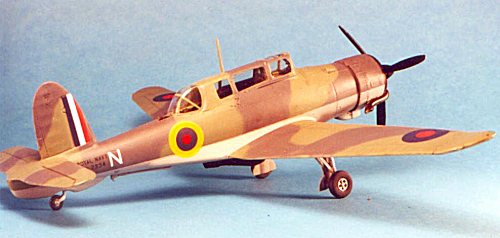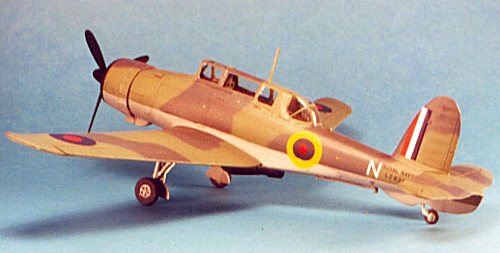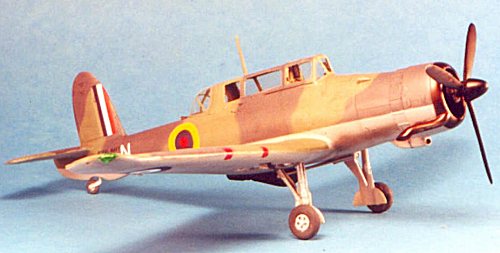
|
KIT: |
Warrior Models 1/48 Blackburn Skua |
|
KIT # |
|
|
PRICE: |
$53.75 |
|
DECALS: |
See review |
|
REVIEW & |
|
|
NOTES: |
Kit is Resin |

|
HISTORY |
The Blackburn Skua was the result of a requirement framed by the Air Ministry in 1934, a requirement that - while technically imaginative - owed much to contemporary tactical misconceptions about the role of carrier aircraft, calling as it did for a multi-purpose fleet defense fighter and dive bomber. While the requirement was technically advanced for 1934, aircraft development was about to accelerate in a completely-unforseen manner; an advanced design of the mid-30s would be obsolescent by 1940 unless it was the subject of a continuing development process that would keep it in the forefront of its class. Sadly, this was not the fate of the Skua.
 The Skua was created by Blackburn's chief designer, G.E. Petty, and was the
first British shipboard aircraft to be built as an all-metal cantilever
monoplane, as well as the first British aircraft designed from the outset to be
a dive bomber. The structure was flush-riveted Alclad; an idea of how modern the
airplane seemed to be would be to compare it with its contemporary
Torpedo/Strike/Reconnaissance deckmate, the Fairey Swordfish. The achilles heel
of the airplane was the decision to use the Bristol Perseus engine, which had
what would turn out to be a puny rating of 850 h.p. In squadron service, in a
flat out level run at full throttle, 2.5 pounds of boost and the Perseus putting
out 2,750 r.p.m. - a power setting that could only be maintained for 5 minutes -
the Skua could turn in a maximum speed of 195 knots. This lowered to 176 knots
if the cowling flaps were opened; the maximum continuous cruise was 160 knots.
That an airplane with this performance would ever have been considered a fighter
is truly amazing. However, a Skua of 803 Squadron recorded the FAA's first kill
of the war on September 25, 1939, bringing down a Dornier Do-18 while escorting
the battleships "Nelson" and "Rodney" off Heligoland.
The Skua was created by Blackburn's chief designer, G.E. Petty, and was the
first British shipboard aircraft to be built as an all-metal cantilever
monoplane, as well as the first British aircraft designed from the outset to be
a dive bomber. The structure was flush-riveted Alclad; an idea of how modern the
airplane seemed to be would be to compare it with its contemporary
Torpedo/Strike/Reconnaissance deckmate, the Fairey Swordfish. The achilles heel
of the airplane was the decision to use the Bristol Perseus engine, which had
what would turn out to be a puny rating of 850 h.p. In squadron service, in a
flat out level run at full throttle, 2.5 pounds of boost and the Perseus putting
out 2,750 r.p.m. - a power setting that could only be maintained for 5 minutes -
the Skua could turn in a maximum speed of 195 knots. This lowered to 176 knots
if the cowling flaps were opened; the maximum continuous cruise was 160 knots.
That an airplane with this performance would ever have been considered a fighter
is truly amazing. However, a Skua of 803 Squadron recorded the FAA's first kill
of the war on September 25, 1939, bringing down a Dornier Do-18 while escorting
the battleships "Nelson" and "Rodney" off Heligoland.
800 and 803 Squadrons took delivery of their Skuas in late 1938, being stationed aboard the new carrier "Ark Royal." 801 Squadron from "Furious" received theirs in the spring of 1939. After a tour of convoy escort duty with "Ark Royal" from Freetown, Sierra Leone, in October and November 1939, the Skuas of 800 and 803 Squadrons were disembarked at Hatston in January 1940. On April 10, 1940, seven 800 Squadron Skuas and nine from 803 made a 330 mile night flight from Hatston across the North Sea, to arrive - at the absolute limit of their range - over Bergen harbor at dawn. They sank the German cruiser "Koinigsberg," which was alongside Skoltegrund Mole. This was the first successful sinking of a warship by dive bombing in history. The two squadrons re-embarked aboard "Ark Royal" 11 days later to cover the invasion of Narvik. During this operation, virtually all the Skuas of both squadrons were lost, some failing to find the carrier and ditching at sea, two force-landing in Sweden, and the others abandoned in Norway during the evacuation. At the same time, Skuas of 801 Squadron provided cover over the Dunkirk evacuation, where they suffered heavy losses.
 With losses replaced, 800 and 803 Squadrons made a Mediterranean tour in the
summer of 1940 aboard "Ark Royal," then were disembarked at Hatston
again that fall. The two squadrons were used on maximum-range shipping strike
missions to Norway, where they were frequently intercepted by Bf-109Es of JG77.
The Skua's defense was to fly low and hug the walls of the fjord. If the rear
gunner was unsuccessful in shooing away the '109, the pilot could drop flaps and
the Messerschmitt pilot would suddenly become very busy trying to avoid a
collision. Losses on these missions were high. 800 Squadron went to sea a third
time aboard "Furious," on a Med tour that saw them return to the UK in
March, 1941, to re-equip with Fulmars.
With losses replaced, 800 and 803 Squadrons made a Mediterranean tour in the
summer of 1940 aboard "Ark Royal," then were disembarked at Hatston
again that fall. The two squadrons were used on maximum-range shipping strike
missions to Norway, where they were frequently intercepted by Bf-109Es of JG77.
The Skua's defense was to fly low and hug the walls of the fjord. If the rear
gunner was unsuccessful in shooing away the '109, the pilot could drop flaps and
the Messerschmitt pilot would suddenly become very busy trying to avoid a
collision. Losses on these missions were high. 800 Squadron went to sea a third
time aboard "Furious," on a Med tour that saw them return to the UK in
March, 1941, to re-equip with Fulmars.
The final proposed mission for the Skua was a plan in the summer of 1941 to gather all remaining Skuas at Exeter for a strike on the "Scharnhorst" and the "Gneisenau" in Brest harbor! While the designated strike leader was willing to take the "death or glory" ride, he pointed out most forcefully to the powers-that-be that Brest was the most heavily-defended target in France, and that most of the valuable aircrews would be lost on a futile mission, since the Skua had no more chance of penetrating the concentrated flak than an iceberg would have of surviving in hell. Common sense prevailed, and the remaining Skuas went back to their final wartime assignments as advanced trainers and target tugs.
|
THE KIT |
Warrior Models is one Tadeusz Bialowas, a modeler and craftsman in Poland, and this Skua is the first of his kits to be marketed outside Poland. The model is a limited-run resin kit with white metal detail parts and two vacuform canopies. The quality of the resin casting is not as primitive as some garage-kit operations, but not as advanced as Spin Models, for example. However, the quality of surface detail is first-class, with petite engraved panel lines and rivet detail, and very acceptable fabric detail on the control surfaces. The wings are molded in upper and lower halves, with the fuselage in right and left halves. There is sufficient cockpit detail to satisfy all but the AMS purist - and since there is as little documentation on the airplane as there is, no one is likely to criticize the model for inaccurate detail. The kit decals are not accurate, according to the experts over at the FAA SIG site, with the national insignia being too large, and the serial numbers not being identifiable as belonging to Skuas. However, since the intended modeler will likely be a serious FAA fan, decals will likely be available in one's collection sufficient to create one of these airplanes.
Tadeusz has told me that he plans to bring out the Blackburn Roc, (a Skua with a turret a la the Boulton-Paul Defiant) and then a Fairey Fulmar. These will both be kits of great interest to those who model Fleet Air Arm subjects and should be very worthwhile based on what is seen with the Skua kit.
|
CONSTRUCTION |
Construction was straightforward. While the instruction sheet is simple, most modelers who have built limited-run kits before will be able to figure things out. There is a good article on the Skua in the November 1977 "Air International," which includes a Pilot Press cutaway drawing, which I found very helpful in figuring out where things go in the cockpit.
Before assembling the cockpit, I painted everything British interior green, with black for instrument panels and other equipment. Test-fitting of parts is mandatory, though I found I didn't need to do a lot of re-shaping. I used a set of Eduard photo-etch RAF seatbelts to add to the detail in the pilot's cockpit.
The wings would be better for the modeler if they had been molded one-piece. As it is, one needs to sand down the joins to get an acceptably-thin trailing edge. It is impossible due to the moldings to get the wings to absolutely true out together as regards thickness and taper, but this would only be apparent if one was presenting the model to a nit-picking IPMS judge in a tightly-judged contest. The wheel wells need to be boxed.

I used enough putty in the wing-fuselage join to expect I would lose most of the surface detail, but interestingly enough I did not.
With test-fitting and sanding, the horizontal stabilizers butt-fitted to the fuselage with no putty needed.
The engine could use more detail, but since I painted it overall semi-gloss black the way FAA engines were finished, there is not that much to see and it is acceptable for all but the detail fanatic.
My biggest problem was cutting the vacuform canopy correctly to fit to the fuselage, since this involved a concave/convex curve. Additionally, one of the canopies had been crushed at the forward end in shipping, so I had to do it right with just the one. This was dipped in Future and then attached with cyanoacrylate, and the joint puttied and later filed and sanded. I made sure to paint the interior color from the inside before installation, when it became clear from the fit that I would be using putty.
|
PAINT & DECALS |
Painting:
The instructions provide a drawing of the camouflage pattern for the sides and upper surfaces. At this time, FAA aircraft were Dark Sea Grey and Slate Grey for upper camouflage, with lower surfaces in Sky Grey rather than the later Sky. I used Tamiya Dark Sea Grey, RLM Grey (a good match for Slate Grey) and Sky Grey for these colors. The exhaust collector ring and stack were painted Model Master Burnt Metal. I painted the wheel wells and interior surfaces of the gear doors and the landing gear aluminum; these airplanes were originally delivered in pre-war aluminum and grey finish, and I did not think they took the time to repaint the landing gear when camouflage was applied.
Decals:
 I used upper Type B roundels for the Wildcat from an Aeromaster sheet, and
made the fuselage insignia using a circle cut from a sheet of yellow, over which
I used a smaller Type B roundel from an old Modeldecal sheet, and the underwing
decals were Type A for the Wildcat. The FAA aircraft at the time of the
Norwegian campaign had been previously marked with Tupe B roundels on upper
surfaces, and were not changed to the A.1 type when the yellow surround was
added in March 1940. I used fin flashes from another old Modeldecal sheet, and
did the serial numbers for this from a sheet of numbers and letters. The
airplane is one from 800 Squadron in early 1940, as shown in a photograph in the
Air International article.
I used upper Type B roundels for the Wildcat from an Aeromaster sheet, and
made the fuselage insignia using a circle cut from a sheet of yellow, over which
I used a smaller Type B roundel from an old Modeldecal sheet, and the underwing
decals were Type A for the Wildcat. The FAA aircraft at the time of the
Norwegian campaign had been previously marked with Tupe B roundels on upper
surfaces, and were not changed to the A.1 type when the yellow surround was
added in March 1940. I used fin flashes from another old Modeldecal sheet, and
did the serial numbers for this from a sheet of numbers and letters. The
airplane is one from 800 Squadron in early 1940, as shown in a photograph in the
Air International article.
Final Finish:
I Futured the model when the decals were set up, then gave several coats of my "Flat Future" mixture to bring it down to a flat sheen. I then attached the landing gear, the bomb, and the propeller, and removed the masking from the canopy. Voila! There sat a model of an 800 Squadron Skua, likely one of the aircraft involved in the "Konigsberg" attack, just what I wanted to create.
|
CONCLUSIONS |
If you are a fan of the FAA in World War II, you will want to get this model, which is available in North America from Pacific Coast Hobbies, and in Europe from Hannant's. The kit makes up into a good-looking model of a historically-significant aircraft, the first to dive bomb a warship and sink it in combat.
Thanks to Tadeusz Bialowas of Warrior Models for providing the review copy. I look forward to his future releases.
If you would like your product reviewed fairly and quickly by a site that has over 900 visits a day, please contact me or see other details in the Note to Contributors.